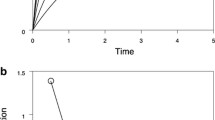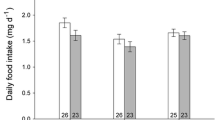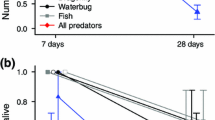Abstract
Predator-generated variation in prey energy intake remains the dominant explanation of adaptive response to predation risk in prey life history, morphology and physiology across a wide range of taxa. This “behavioural hypothesis” suggest that chemical or visual signals of predation risk reduce prey energy intake leading to a life history characterized by a small size and late age at maturity. However, size-selective predation can induce either smaller size–early age or large size–late age life history. The alternative “physiological hypothesis” suggests that size-selective cues decouple the relationship between energy and life history, acting instead directly on development. Here we use a series of experiments in a fish–daphnid predator–prey system to ask whether size-selective predator cues induce a physiological mediation of development, overshadowing behaviourally based changes in food intake. We found fish chemical cues reduce the net energy intake in Daphnia magna, suggesting a behaviourally mediated reduction in energy. Experimental manipulation of food levels show further that reductions in food lead to later but smaller size at maturity. However, in line with the physiological hypothesis, we show that D. magna matures earlier and at a smaller size when exposed to fish predation cues. Furthermore, our data shows that they do this by increasing their development rate (earlier maturity) for a given growth rate, resulting in a smaller size at maturity. Our data, from a classic size-selective predation system, indicate that predator-induced changes in this system are driven by physiological mediation of development rather than behavioural mediation of energy intake.




Similar content being viewed by others
References
Abrams PA, Rowe L (1996) The effects of predation on the age and size of maturity of prey. Evolution 50:1052–1061
ASTM (1989) Standard guide for conducting acute toxicity tests with fishes, macroinvertebrates and amphibians. Annual book of ASTM standards, vol 11.04, pp 379–397
Baird DJ, Barber I, Calow P (1990) Clonal variation in general responses of Daphnia magna straus to toxic stress .1. Chronic life-history effects. Funct Ecol 4:399–407
Ball SL, Baker RL (1995) The nonlethal effects of predators and the influence of food availability on life-history of adult Chironomus tentans (Diptera, Chironomidae). Freshwater Biol 34:1–12
Ball SL, Baker RL (1996) Predator-induced life history changes: antipredator behavior costs or facultative life history shifts? Ecology 77:1116–1124
Barata C, Baird DJ, Soares A (2001) Phenotypic plasticity in Daphnia magna straus: variable maturation instar as an adaptive response to predation pressure. Oecologia 129:220–227
Beckerman AP, Benton TG, Lapsley CT, Koesters N (2005) How effective are maternal effects at having effects? Proc R Soc Lond Ser B 273:485–493
Benard MF (2004) Predator-induced phenotypic plasticity in organisms with complex life histories. Annu Rev Ecol Evol Syst 35:651–673
Crowl TA, Covich AP (1990) Predator-induced life-history shifts in a fresh-water snail. Science 247:949–951
Fox GA (2000) Failure time analysis: studying times-to-events and rates at which events occur. In: Scheiner SM, Gurevitch J (eds) Design and analysis of ecological experiments, 2nd edn. Oxford University Press, Oxford
Gilliam JF, Fraser DF (1987) Habitat selection under predation hazard—test of a model with foraging minnows. Ecology 68:1856–1862
Gliwicz ZM, Pijanowska J (1993) The role of predation in zooplankton succession. In: Sommer U (ed) Plankton ecology: succession in plankton communities. Springer, Berlin Heidelberg New York, pp 253–296
Hall DJ, Threkeld ST, Burns CW, Crowley PH (1976) The size efficiency hypothesis and the size structure of zooplankton communities. Annu Rev Ecol Syst 7:177–208
Hoverman J, Auld J, Relyea R (2005) Putting prey back together again: integrating predator-induced behavior, morphology, and life history. Oecologia 144:481–491
Ihaka R, Gentleman R (1996) R: a language for data analysis and graphics. J Comput Graph Stat 5:299–314
Johansson F, Stoks R, Rowe L, De Block M (2001) Life history plasticity in a damselfly: effects of combined time and biotic constraints. Ecology 82:1857–1869
Laforsch C, Tollrian R (2004) Embryological aspects of inducible morphological defenses in Daphnia. J Morphol 262:701–707
Lass S, Spaak P (2003) Chemically induced anti-predator defences in plankton: a review. Hydrobiologia 491:221–239
Lima SL (1998a) Nonlethal effects in the ecology of predator–prey interactions—What are the ecological effects of anti-predator decision-making? Bioscience 48:25–34
Lima SL (1998b) Stress and decision making under the risk of predation: recent developments from behavioral, reproductive, and ecological perspectives. In: Stress and behavior, vol 27. pp 215–290
Lima SL, Dill LM (1990) Behavioral decisions made under the risk of predation—a review and prospectus. Can J Zool 68:619–640
Ludwig D, Rowe L (1990) Life-history strategies for energy gain and predator avoidance under time constraints. Am Nat 135:686–707
McCauley E, Murdoch WW, Nisbet RM (1990) Growth, reproduction, and mortality of Daphnia-Pulex Leydig. Life Low Food 4:505–514
McPeek MA, Crowley PH (1987) The effects of density and relative size on the aggressive—behavior, movement and feeding of damselfly larvae (Odonata, Coenagrionidae). Anim Behav 35:1051–1061
NIH (2004) Image J—NIH Image program (developed at the U.S. National Institutes of Health and available on the Internet at http://www.rsb.info.nih.gov/nih-image/)”. In, pp http://www.rsb.info.nih.gov/nih-image/
Noonburg EG, Nisbet RM (2005) Behavioural and physiological responses to food availability and predation risk. Evol Ecol Res 7:89–104
Parejko K (1992) Embryology of chaoborus-induced spines in Daphnia pulex. Hydrobiologia 231:77–84
Ramcharan CW, Dodson SI, Lee J (1992) Predation risk, prey behavior, and feeding rate in Daphnia pulex. Can J Fish Aquat Sci 49:159–165
Relyea RA (2002) The many faces of predation: how induction, selection, and thinning combine to alter prey phenotypes. Ecology 83:1953–1964
Reznick D, Bryant MJ, Bashey F (2002) r- and K-selection revisited: the role of population regulation in life-history evolution. Ecology 83:1509–1520
Riessen HP (1999) Predator-induced life history shifts in Daphnia: a synthesis of studies using meta-analysis. Can J Fish Aquat Sci 56:2487–2494
Rowe L, Ludwig D (1991) Size and timing of metamorphosis in complex life-cycles—time constraints and variation. Ecology 72:413–427
Sih A (1987) Predators and prey lifestyles: an evolutionary and ecological overview. In: Kerfoot WC, Sih A (eds) Predation: direct and indirect impacts on aquatic communties. University of New England Press, Hanover, pp 203–244
Skelly DK (1992) Field evidence for a cost of behavioral antipredator response in a larval amphibian. Ecology 73:704–708
Skelly DK (1994) Activity level and the susceptibility of anuran larvae to predation. Anim Behav 47:465–468
Skelly DK, Werner EE (1990) Behavioral and life-historical responses of larval American toads to an odonate predator. Ecology 71:2313–2322
Stibor H (2002) The role of yolk protein dynamics and predator kairomones for the life history of Daphnia magna. Ecology 83:362–369
Stibor H, Luning J (1994) Predator-induced phenotypic variation in the pattern of growth and reproduction in Daphnia hyalina (Crustacea, Cladocera). Funct Ecol 8:97–101
Stibor H, Machacek J (1998) The influence of fish-exuded chemical signals on the carbon budget of Daphnia. Limnol Oceanogr 43:997–1000
Stoks R, McPeek MA (2003) Predators and life histories shape Lestes damselfly assemblages along a freshwater habitat gradient. Ecology 84:1576–1587
Taylor BE, Gabriel W (1992) To grow or not to grow—optimal resource-allocation for Daphnia. Am Nat 139:248–266
Tollrian R, Harvell CD (1999) The ecology and evolution of inducible defenses. Princeton University Press, Princeton, N.J.
Wellborn GA, Skelly DK, Werner EE (1996) Mechanisms creating community structure across a freshwater habitat gradient. Annu Rev Ecol Syst 27:337–363
Werner EE, Gilliam JF (1984) The ontogenetic niche and species interactions in size structured populations. Annu Rev Ecol Syst 15:393–425
Winder M, Boersma M, Spaak P (2003) On the cost of vertical migration: are feeding conditions really worse at greater depths? Freshwater Biol 48:383–393
Acknowledgements
We thank the technical staff in the Environment Group of the Institute of Aquaculture at the University of Stirling. A. P. B. was funded by a NERC fellowship (NERC UK:NE/X500166/1). The investigation was partially supported through an award to K. W. from the European Union Access to Research Infrastructures Action of the Improving Human Potential Programme (HPRI-T-2001-00180). We thank H. Stibor, two anonymous reviewers and E. Hammill, S. Plaistow and S. Humphries for helpful comments.
Author information
Authors and Affiliations
Corresponding author
Additional information
Communicated by Bernhard Stadler.
Rights and permissions
About this article
Cite this article
Beckerman, A.P., Wieski, K. & Baird, D.J. Behavioural versus physiological mediation of life history under predation risk. Oecologia 152, 335–343 (2007). https://doi.org/10.1007/s00442-006-0642-6
Received:
Accepted:
Published:
Issue Date:
DOI: https://doi.org/10.1007/s00442-006-0642-6




